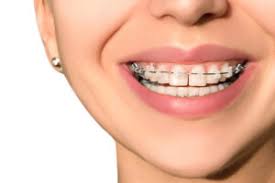
- Teeth fixing is a best solution for a perfect smile as beautiful smile enhances self-confidence and this is reflected in general health. If you suffer from problems in your teeth such as crookedness, fractures, or even an increase in pigmentation, there are many solutions that dentistry has come up with recently.
What are the types of teeth fixing ?
Problems that fall under the category of irregular teeth and lead to an incorrect smile shape and difficulties in chewing and speaking:
1- Traditional metal braces :
It consists of wires and clips made of metal, which in turn apply pressure on the teeth to correct their position. It is suitable for severe cases of crookedness, and the treatment period ranges from one year to up to three years.
2- Transparent braces:
It relies on transparent molds that are changed regularly to move the teeth gradually. It is suitable for mild to moderate cases and is considered a cosmetic option that is less noticeable in appearance and more comfortable for the patient.
3- Cosmetic veneers :
It is a thin layer made of ceramic or porcelain that is glued to the front surface of the teeth. It gives a bright white appearance and covers defects in the teeth, such as small gaps or asymmetry. It lasts for long periods provided that the teeth are taken care of throughout their existence.
Teeth fixing of broken or damaged teeth:
Some people may cause a reason to treat fractures or cracks as a result of that, or advanced caries, and the most important methods are:
1- Cosmetic fillings :
Cosmetic fillings are used to repair small holes in teeth or to treat cavities in general. They are available in different types, such as white optical fillings that completely match the natural color of the teeth.
2- Dental crowns :
It completely covers the tooth to protect it from damage and return it to its natural shape. It is usually made of materials such as porcelain or zirconia to look very natural. It is used in cases of patients in which the tooth is very weak after a severe fracture or root canal treatment.
3- Nerve filling treatment:
It is used when the decay reaches the inner nerve of the tooth. It includes cleaning the nerve canal and closing it with a special filling to prevent infection, protect the tooth from extraction, and also preserve it for as long as possible.
Replacing missing teeth:
The loss of teeth affects the ability to chew and speak, and also negatively affects the appearance. Available solutions include:
1- Dental implants :
It is considered the best in treating missing teeth permanently. It relies on implanting artificial roots made of titanium in the jaw bones and then installing an artificial crown for the tooth. It gives a very natural appearance to the teeth, but it may take a period of up to several months for complete healing.
2- Fixed bridges :
Crowns are used that the doctor attaches to the adjacent teeth to replace the missing teeth. This technique requires filing the adjacent teeth to form a base for the bridge. This solution is considered stable, but it requires the presence of strong teeth next to it.
3-Moving installations:
This solution is considered the ideal choice for the elderly or for people who do not want surgery, and it includes partial or complete dentures that can be removed and cleaned with ease.
Teeth fixing including teeth whitening and improving their appearance :
If you suffer from pigmentation or yellowing in the color of your teeth, there are several ways to whiten them or give them a natural appearance:
1- Laser teeth whitening:
It is a procedure that is performed in one session quickly in the dental clinic and uses a laser to activate the bleaching agent, which gives an immediate and effective result.
2- Home teeth whitening :
The doctor prescribes the use of trays containing whitening gel and requires a lower cost compared to whitening in clinics, but it takes longer to give the desired result and teeth fixing.
3- Use whitening pastes :
This is done by removing pigmentation using bleaching materials. It is considered an effective solution with regular use, but it does not give the best result like laser.
Teeth fixing after treatment:
After orthodontic procedures or implant treatment, it is necessary to fix the teeth in place to maintain the results of the repairs and avoid returning to the old position of the teeth. This is done by:
1- Installed wires :
Fixed wires are used after removing the braces to keep the teeth in their new place. They are placed behind the front teeth on the lower jaw or upper jaw. These wires may be fixed or removable depending on the patient’s condition.
2- Transparent devices (retainers) :
They are removable devices used after treatment to fix the teeth in their new place. They are invisible or transparent and are usually made of clear plastic. They are used for several months or years according to the doctor’s recommendations to ensure that the teeth remain fixed.
3- Regular follow-up with the dentist:
After installing and teeth fixing , you must visit the doctor periodically to ensure that the teeth do not move again. The doctor may need to modify or replace the devices used depending on the development of the dental condition.
Tips for maintaining dental health and beauty before heading to clinics for teeth fixing :
Regardless of the type of treatment you choose, there are some tips to protect your teeth from future problems or to preserve the results of your repairs, including:
1- Make sure to brush your teeth twice daily using a toothpaste that contains fluoride.
2- Use dental floss daily to remove food debris from between the teeth.
3- Stay away from soft drinks, alcohol, and smoking to avoid tooth erosion and stains that are difficult to treat.
4- Make sure to visit the dentist regularly for regular reassurance and early detection of any dental problems and treatment from the beginning.
5- Follow a healthy diet that contains elements rich in calcium and vitamins that are important for dental health.
Read also about :
the healing art of cupping therapy



